By
Gary (Dr. J) Johnson
Image: The audience at Roll-Air Outdoor Skating Rink. Source: Gary Johnson
On August 26,
1969, the 1st Michigan Pop Festival, became the biggest rock and roll event in Bay City, Michigan, during the 1960s.
It drew an estimated 4,000 music lovers to the Roll-Air outdoor skating rink on State Park Drive for a day-long show that
featured some of the state’s finest bands.
Although this type of event was new to Bay City,
similar festivals had been held in cities across the state, the first being Detroit’s Belle Isle Love-In followed by
the Southfield Pop Festival in 1967. Festivals in 1968 included the first Saugatuck Pop Festival, the Oakland Pop Festival,
Detroit’s Dialogue ’68, and the Kalamazoo Pop Festival.
The festival movement blossomed
in Michigan in 1969. Detroit staged three more large music events that year, and by early August there had also been pop/rock
festivals held in Grand Rapids, Saginaw, Midland, Kalamazoo, Saugatuck, Petoskey, Mt. Clemens, and at Delta Community College.
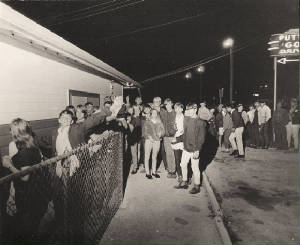
Image: Crowd outside the Roll-Air skating rink. Source: Gary Johnson
Scheduled
less than two weeks after the nationally acclaimed Woodstock Festival held at Max Yasgur’s 600-acre dairy farm, near
the town of Bethel, New York. The 1st Michigan Pop Festival, with an estimated crowd of 4,000, paled in comparison
to Woodstock’s 400,000 attendees and 32 performing acts. Numbers aside, however, the Bay City event and the other 1969
festivals in the state occurred at what seemed to be a peak time for Michigan rock and roll bands.
During
the previous year, a number of the state’s top groups had signed recording contracts with nationally-known labels and
had already released albums. The Bob Seger System and SRC were signed to Capitol, The Frost with Vanguard,
The Amboy Dukes were on Mainstream, Frijid Pink was signed to Parrot, and both the MC5 and The Stooges were on Elektra Records.
The Rationals had inked a contract with Crewe Records and were working on their debut album; and a new group called
Grand Funk Railroad had recently signed with Capitol Records even though they had formed just months earlier.
In
addition, some of the Michigan bands had also enjoyed hit singles on Billboard’s Hot 100 during the past 12
months. Both The Amboy Dukes’ “Journey To The Center Of The Mind”, and the Bob Seger
System’s “Ramblin’ Gamblin’ Man” were Top 20 hits; and the MC5’s controversial “Kick
Out The Jams” also charted early in 1969.
Roll-Air was a walled-in outdoor skating facility
that, along with Putt Tee miniature golf and Tony’s Amusement Park, was part of a popular summer entertainment complex
located just west of Bay City State Park. The owners were two married couples who were also educators in
Bay City schools. Bob and Ilene Darbee and Octavian and Chris Gavrila had purchased the properties in the 1960s and had turned
the Roll-Air skating rink into a weekly rock and roll hotspot.
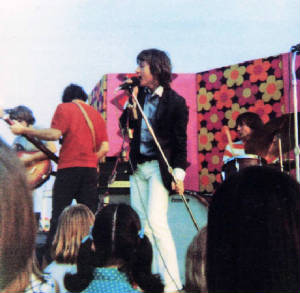
Image: Rationals at Roll-Air Pop Festival. Source: Gary Johnson
They
accomplished this by partnering with DJs Bob Dyer and Dick Fabian from WKNX-AM to host teen dances and the extremely popular
Battle of the Bands competitions on Tuesday nights. After a few years, the rock and roll nights had evolved
into concerts featuring top Detroit-area bands. It was common for these weekly events to attract 2,000
teens into the 70 ft. x 206 ft. concrete-floored skating rink.
According to the Bay City Times
article ‘Pop Festival Draws Thousands’, published the next day on August 27th, three organizations
– Tony’s Amusement Park, WKNX Radio, and Mike Quatro Inc. – collaborated to bring the festival to Bay City.
Bob Darbee and Octavian Gavrila, owners of Tony’s Park and Roll-Air, organized the operation and the physical plant.
Quatro provided the entertainment, and WKNX with Bob Dyer added the publicity and co-sponsored the event.
Bob
Dyer was already a legend at WKNX, mid-Michigan’s most popular AM station in the 1960s. He had joined
the station in 1950 and, in those pre-rock days, had hosted live country music shows on the air and booked country acts at
the Saginaw Auditorium. When WKNX-TV started broadcasting in 1953, Dyer was one of the station’s
early on-air personalities. By the mid-1950s, Dyer smoothly moved into playing rock and roll on his daily
show and quickly became one of the area’s most popular DJs.
Dyer was honored by Billboard
magazine in 1960 and also received an accolade from Michigan governor G. Mennen “Soapy” Williams for his on-air
achievements. After co-hosting the weekly Battle of the Bands for three years at Roll-Air, Dyer, along with fellow DJ Dick
Fabian, started renting the gymnasium at the Saginaw Y.M.C.A. for Saturday dance/concerts that they called the Y A-Go-Go.
Booking national acts through the famous William Morris Agency, Dyer and Fabian brought performers like Simon &
Garfunkel, the Dave Clark Five, Glen Campbell, and the Lovin’ Spoonful to their Saginaw events.
Read
the entire story of the festival at: https://michiganrockandrolllegends.com/index.php/blog/186-bay-city-s-1st-michigan-pop-festival
Enjoy more great Michigan rock and roll history by visiting the Michigan Rock and Roll Legends
Hall of Fame exhibit at the Historical Museum of Bay County.
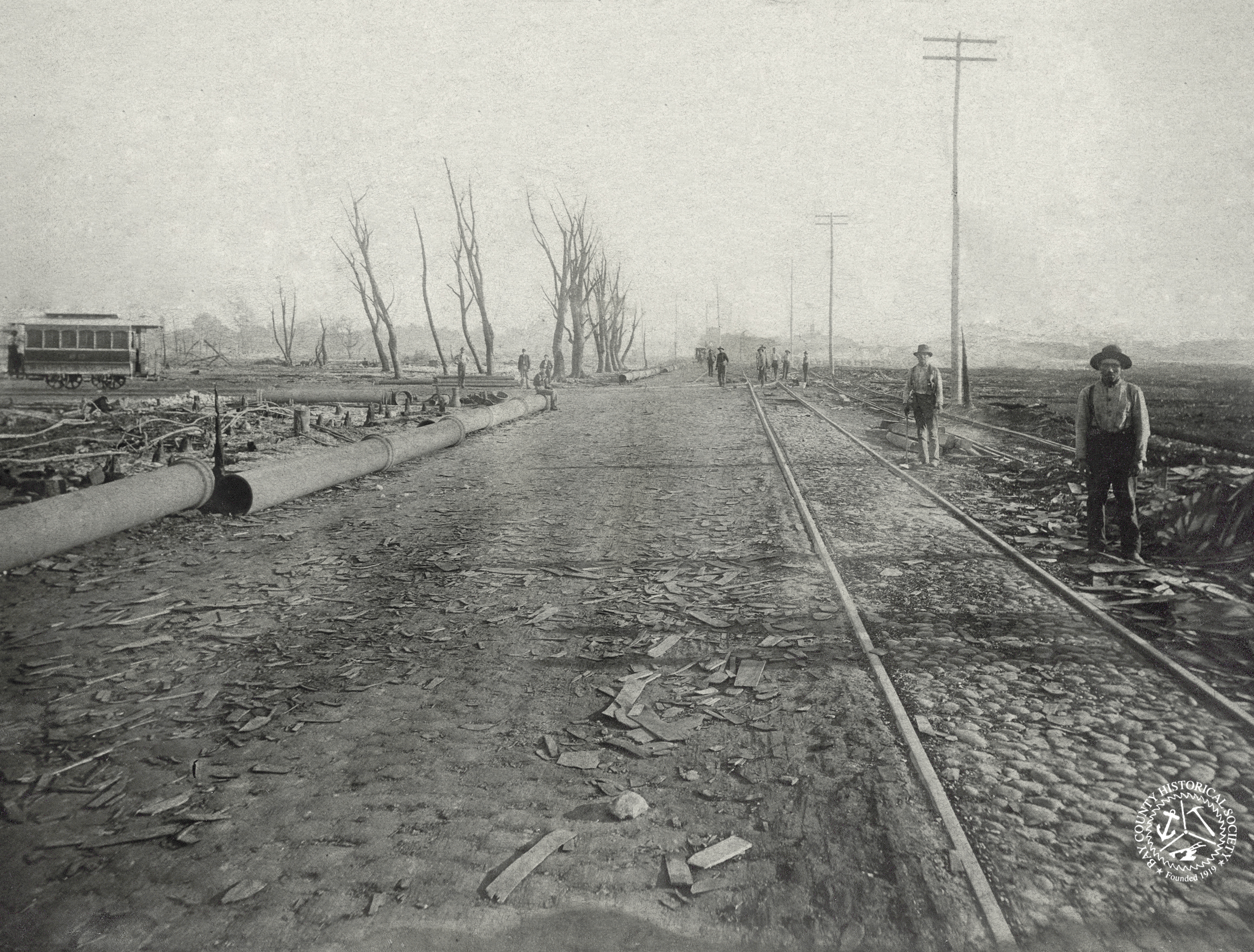
Image: View looking North on
Broadway. The left side of the photograph is where Miller & Turner would have been located. Source: Bay County Historical
Society
In July of 1892, a fire blazed through South Bay City, which decreased the manufacture of lumber, significantly.
Albert Miller and his family lost significant businesses, one on the Middle Grounds and another at the foot of 33rd
Street in Bay City’s south end. A few weeks before, Miller’s son’s box factory and planing
mill had also gone up in smoke.
The Miller Bros. Fire

Image: Judge Albert Miller, Started the Miller & Turner Mill in 1851
On
July 23, 1892, just after 6:00 a.m., an alarm rang out from fire alarm box 63 at 23rd and Water. Men,
women, and children flocked to the scene: Miller Bros Mill was up in flames. The mill, located to the north of the Middle
Grounds and just north of the 23rd Street Bridge was owned by Andrew Albert and James Miller. It
was erected in the late 1870s.
Theories were swirling as to how a fire of this magnitude had started.
Some said that they thought it was started by someone lighting a pipe inside of the mill and dropping a match in sawdust
debris. Witnesses say that the fire started at the southwest corner of the mill closest to West Bay City. However,
that day was particularly windy. Gales came in and blew the wind in an easterly direction.
By
7 a.m., the fire was raging. It has spread to tramways in different directions. The
heat of the day made it even worse for the firemen. There were no hydrants located near the mill.
Unfortunately, the closest was at Water and 23rd and was too far away to use. The 4th,
5th, 7th ward hose companies, steamer Neptune, hook-and-ladder truck, and chemical engine all came to help where they could.
Neptune was stationed on the bridge and pumped water from the river to the fire.
Requests were made to West Bay City
for use of an additional steamer and hose. Steamer Defiance arrived and by 8:00 a.m. the fire was under
control and it was thought that the danger of the flames spreading to other properties was over.
Unfortunately,
the mill only had $1000.00 of insurance on it. It was estimated that there was a loss of over $30,000.
The fire itself was still smoldering more than a week later.
South End Fire
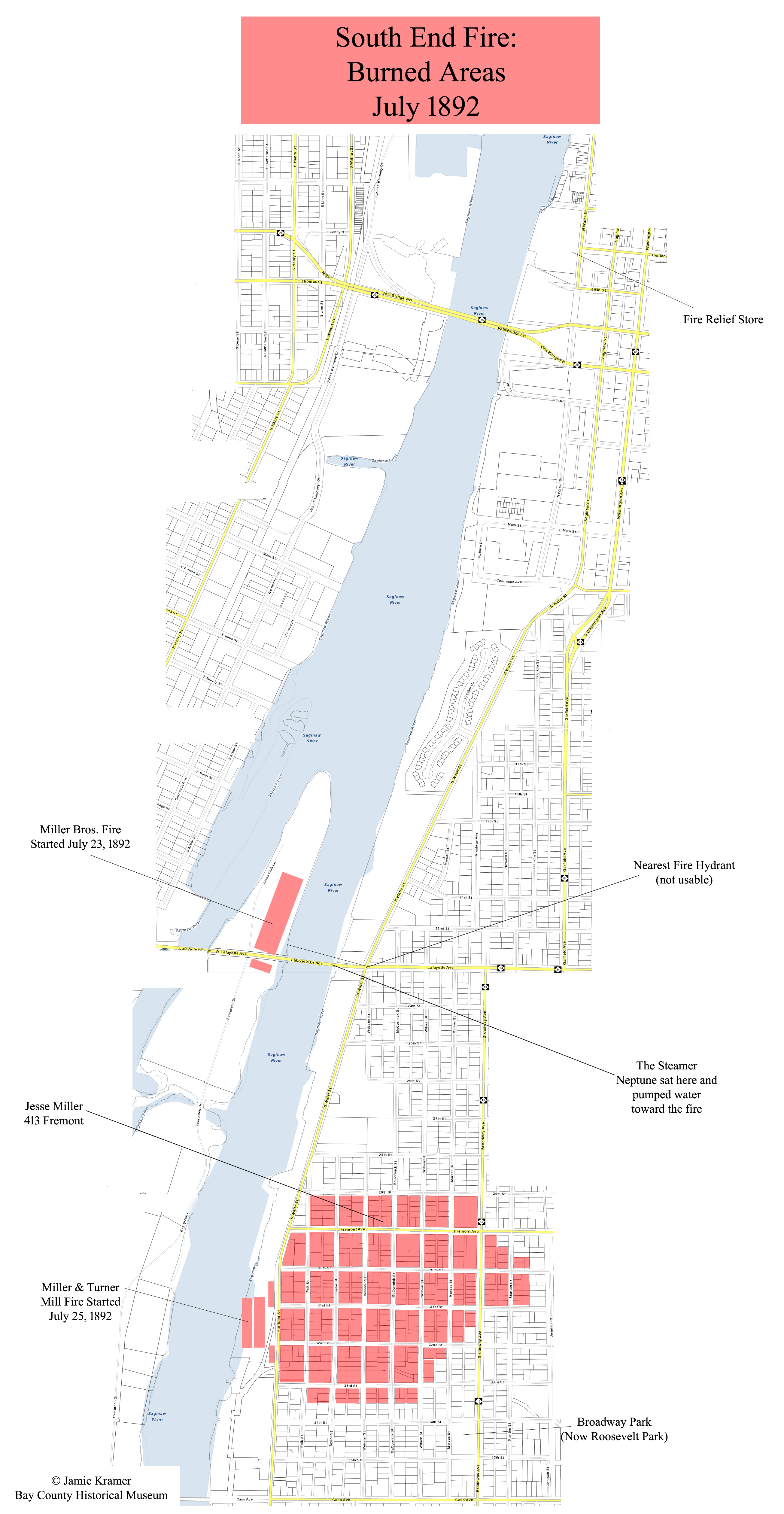 Two days later on the 25th at 2:00 p.m., alarms rang out again
when the lumber piles of Miller & Turner’s Mill caught fire. Winds were still heavy spreading
the flames at rapid speed. Boards that had caught on fire were blowing into the wind, landing on houses,
and catching them on fire. The scene was described by the Bay City Times a being a “Cyclone of dust and smoke all over
the south end of Bay City.” Wind blew the fire, spreading it, across Harrison Street and taking out a hardware store
and a row of frame buildings that extending that entire block. Within 10 minutes all of Harrison Street
was on fire. Firemen laid water hose along Water Street. They were not equipped for
a fire of this scale. It ran hot and spread fast. It was called “one of the most serious conflagrations
which have ever visited this city” (BCT 7/25/1992_5). West Bay City sent every company that could be spared.
Two days later on the 25th at 2:00 p.m., alarms rang out again
when the lumber piles of Miller & Turner’s Mill caught fire. Winds were still heavy spreading
the flames at rapid speed. Boards that had caught on fire were blowing into the wind, landing on houses,
and catching them on fire. The scene was described by the Bay City Times a being a “Cyclone of dust and smoke all over
the south end of Bay City.” Wind blew the fire, spreading it, across Harrison Street and taking out a hardware store
and a row of frame buildings that extending that entire block. Within 10 minutes all of Harrison Street
was on fire. Firemen laid water hose along Water Street. They were not equipped for
a fire of this scale. It ran hot and spread fast. It was called “one of the most serious conflagrations
which have ever visited this city” (BCT 7/25/1992_5). West Bay City sent every company that could be spared.
People continued to ban together to salvage what they could of household items. Items were quickly
taken from buildings that were in the process of burning and others that were in danger.
At 3:00 p.m., a call was
placed to Saginaw for aid. A fire steamer and two hose carts were on their way. Flint
was also called for assistance. Stated in the Bay City Times, “The combined efforts of the departments
of the four cities could do little toward checking the flames,” (BCT, 26 Jul 1892). By 3:15, Miller
& Turner’s Mill and buildings were overtaken.
At 3:45 p.m. the wind direction changed. Harrison
Street was almost completely burned away. Flames had spread to Fremont Avenue and Webster Street, four
blocks away from where the fire started. The fire was still not slowing. Dwellings between 30th
and 32nd Street, as well as East of McCormick, had been destroyed or continued to burn. The
fire then reached Polk, Taylor, and 30th, 31st, 32nd, Fremont Baptist church (which was leveled
almost instantly). Flames from the church went as far as 29th. The fire passed east on Wilson to Marsac, then north
half a block, and north on Marsac, where it cut northeast half a block” (BCT, 26 Jul 1892). The Fremont Avenue Methodist
Church between Taylor and McCormick was enveloped in flames.
The fires burned so hot that railroad tracks were
twisting and warping. The cobblestone broke away. Street car tracks were also curling.
Michigan Central Railroad lost three box cars.
At 5:00 p.m., the flames were still spreading. 1800 Broadway
caught fire and was destroyed. At 7:30 p.m. the fire was finally under control. However, firemen stayed
stationed through the next day. By July 26th, there were 232 dwellings, 2 churches, 30 stores and saloons, 3 hotels,
1 roller rink, 38 barns, 1 blacksmith shop, 1 paint shop, a livery stable, and an office, shingle shed, sawmill, salt block,
cooper shop, and two lumber yards lost.
After the Fire
By
the end of the fire, the view between Harrison and Broadway and 28th Street all the way through 33rd
Street was an unobstructed view. Trees that had been standing in the 6th ward for “half a century”
were destroyed (BCT, 26 Jul 1892).
“The telephone wires had been burned away and communication with the lower
part of the city was cut off, but messengers were sent there post haste and every available vehicle in the city, slab carts,
lumber wagons, drays, delivery wagons and everything on wheels, even dog carts were ushered into service to remove household
goods” before people’s homes were completely swept away” (BCT, 26 Jul 1892).
Another unforeseen issue
had to do with sanitation. Many privies and cisterns were left open, the tops of them having been burned
away. Not only was it an issue concerning sanitation, but safety. Open wells dotted
the South End and there was worry that people would fall in them.
People from all over came to Bay City’s South
End to see the devastation. Hundreds of people arrived daily from Flint and Saginaw and large excursions were planned out
of Detroit.
Relief
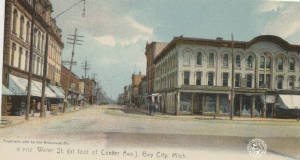
Image: The relief headquarters would have been around this intersection
in 1892, toward the left hand side of the postcard. Fraser House would have been to the right. Source: Bay County Historical
Society.
An emergency meeting of the Common Council gathered. The Mayor appointed a committee of three
citizens and three members of the council to give those affected immediate relief. They also encouraged “liberal, open
hearted and generous people,” to give what they could. They had asked that merchants sell products to the victims at
low prices for 60 days. Manufacturing industries were called to help replace homes destroyed and give employment
to those out of work.
R.B. Taylor had suggested that the $25,000 the city had set aside for the new city
hall, be utilized in rebuilding the burned factories. He had also called for the thousands of feet of hose
that the fire department lost, to be replaced at $1.00 per foot. However, Alderman Switzer said that according
to law this money could not be reallocated (BCT, 27 Jul 1892).
Relief headquarters were set up opposite of Fraser
House. Those affected by the fire would go to the headquarters and request the items needed.
The relief headquarters gave relief first to those who lost everything and did not have insurance or goods, and then
those who owned their property but didn’t have insurance, and lastly to store owners and home owners that had partial
insurance. Food continued to be sent to Broadway Park and the Union Block Store was used for clothing and
household goods.
C.D. Vail, of the relief committee stated that “the citizens are responding generously to the call for aid,
but the demand is so great we are unable to anywhere near supply it. Hundreds of applications have been
made for us for children’s shoes and clothing, and we have been under the painful necessity of letting the poor people
leave empty-handed. The committee would be very grateful for donations of shoes and clothing, especially
for the little folks. We are also in need of all kinds of household goods,” (BCT, 29 Jul 1892).
Broadway Park (now Roosevelt Park)
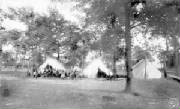
Image
Source: Bay County Historical Society
Broadway Park was used as an escape for the people who had lost their homes. Tents
were erected. Grocers delivered provisions for people to be fed. People were stationed at the park to help
care for the families and keep track of the food. They also used the park for the household goods that
were removed from the homes. The idea was that people would be able to claim their items.
“We
are doing everything possible to take care of the hungry,’ remarked C.H. Ueberroth, of the Broadway Park Committee.
‘We must have fed 1,000 people Tuesday and as many Wednesday. I tell you it makes tears come to our
eyes to see the suffering. It is something the people down town cannot realize because it is so aggravated.
We must have help or else the people will continue to suffer. They have not only lost their homes,
but they have not the means with which to buy a bit to eat. We must feed them until they are taken care
of. They cannot be allowed to starve right under our eyes when so many have plenty. We
see children, little ones, barefooted, bareheaded and with hardly a stitch to their back, come to us asking for something
to eat,” (BCT, 29 Jul 1892).
By July 30, 1892, families were no longer using the park as temporary housing.
Housing had been found for all families. Some landlords that owned housing in Saginaw moved some
of the victims there. The tents that had been erected in Broadway Park were still being used for unclaimed
goods.
Donations
Attorney Weadock moved that Mr. Cranage open the subscription list—many individuals
and businesses gave a donation of upwards of $500.00. The Michigan Central Railroad donated $1000.00 to
the relief fund. They also began asking their passengers for donations to go to the relief.
By July 29th, over $12,000 had been donated.
Manufacturing companies
offered the use of their machinery and workshops for when people were ready to rebuild. Ross, Brandley & Co offered special
rates on building materials.
Bay City and West Bay City citizens were continuously supplying clothes and household
goods daily. Many stores also donated clothing. Walther’s Store contributed “100 cups and saucers,
100 plates, 50 stew pans, 48 10-quart pails, 50 pudding pans, 25 crocks and 20 tea and coffee pots” (BCT, 29 Jul 1892).
Living spaces were also donated. The Arious Society offered use of their hall as temporary quarters
for people without homes. Mrs. Caroline M. Till, who owned buildings on Water Street, opened some of the space to those who
lost everything in the fire. She had enough space for three families and allowed them to stay for a month
free of charge.
Donations came from places all over the state and throughout the country. Monetary donations were sent from Detroit,
Saginaw, Marquette, and Grand Rapids. Saginaw sent extensive groceries to the fire relief.
States throughout the country sent letters and well wishes. Illinois, Indiana, Massachusetts, New
York, Ohio, and Pennsylvania, also sent donations.
Benefits for the Cause
Benefits started arising around
Michigan. The ladies of the Mehan Quartet gave a concert at the opera house to gather more donations for
the fire victims. Professor Walton’s Military Band also gave a concert. Concerts were held at the
Arbeiter Garden Park, where the Third Regiment Band played a concert. The Essexville band gave a concert at Arion Park.
Professor L. Bernstein made a donation of 400 admission tickets to his ‘Museum of Anatomy’ on Water Street
near Center, to be sold to benefit the fire victims. Concerts held at Germania Garden in Saginaw and a
performance by the Elite Minstrel Quartet netted over $3,000 (BCT, 30 Jul 1892).
Those Affected
There was said to be only one casualty of the burned district. Jesse M. Miller was a long-time
resident who had lived in the south-end for years. His house at 415 Fremont was a noted landmark. The day
of the fire he had been seen diligently working to save his home. It was said that Miller went back into
his home to recover the money he had stashed away. However, in his attempt to escape it was too late. Once
the fires were out the remains of his body was found.
40 blocks had been burned.
300 families or 1,300 people had lost their homes. A large percentage of these families were said
to have been “left penniless,” and had little to no insurance (BCT, 26 Jul 1892).
What was not burned was
moved out to Broadway Park. “People were looking for lost articles all over the city, clothes, sewing
machines and other household goods” (BCT, 29 Jul 1892). Others were said to be going through the
ruins and pilfering items.
Conclusion

Image: View looking North on Broadway. The left side of the photograph is where Miller & Turner would have
been located. Source: Bay County Historical Society
No one really knows what caused either fire on Bay City’s East Side in July
of 1892. There is much speculation surrounding it. It is also unknown if the first fire
even had anything to do with the second, as some sources blame a possible spark from the tug “Haight’s”
funnel (BCT, 26 Jul 1892). However, what is known is the evidence that two communities
pulled together to aid both the businesses and families of Bay City’s 6th Ward.
On
August 10, 1892, the Bay City Times published a poem that was written by Stone Road Commissioner, William Henry, that was
entitled “The Great Fire.” He was inspired during the fire’s raging on July 25, 1892.
The
Great Fire
The sun was one hundred in the shade
To-day
and the wind it blew a gale.
And there was a fire broke out to-day
At Miller’s and Turner’s mill in South
Bay City that caused thousands
for to wail.
It was a little after one o’clock that the fire bell did sound
and soon Chief Harding with all his hosts was at their posts the fire for to drown’d.
But
the flames they spread both north and south, then east to Harrison Street,
And
like a hungry lion in search of prey they licked up everything complete;
Nor
were they satisfied with Harrison Street and all of Miller & Turner’s docks,
But
they hastened on their mad career till they wiped out forty blocks.
Three hundred
and sixteen buildings is burned down to the ground.
And nothing but the nails
that held them together is anywhere to be found.
And the trees and shrubs
that adorned the streets and made a shade for many a wearied brow,
What is left
is standing black all over this wasteless track but there is
No leaves upon them now.
Twenty-five or thirty years ago I sold hundreds of those trees and hardly
one of them has been broke
But little I thought when they from me were bought
that I would see them carried off in smoke.
And the street car track was burned
and warped but the company’s force did rally,
And in great haste they
were soon well placed by the Superintendent Mr. Alley.
This is a terrible calamity that has on our citizens fell,
So if you
give me time I will try in this
My rhyme a few of their names to tell.
The first is Albert Miller & Sons, that lost most everything they had
Then
Beebe, Reynolds, Johnson, Stover & Larkin for them we do feel bad;
Then Campter,
the barber and Richardson and Nash who kept a grocery store,
Then Gardiner and Laird
had no insurance, at least so I have heard, and I supposed there was hundreds more.
And Silas Forcia’s mammoth store was all wiped out to-day,
And
all that Uncle Thorp had left was on a wheelbarrow, and he was wheeling them away.
It
was a hustling time and the fire did roar and crack,
And thousands of poor
people was glad to get away with the clothes upon their back.
But
thousands came through fire and smoke to lend a helping hand,
And many
things did save from the fiery wave just as long as they could stand.
Yes it is
a great destruction and it fills many hearts with sorrow.
And
I do declare I can only it compare to the burning of Sodom and Gomorrah.
But of all that befell South Bay City
I will tell you of its greatest
loss,
That is the burning to death of Jesse M. Miller, that old soldier of
the cross.
He was a man that feared not death and to him it was no foe
I remember he said to me one day because Jesus lives, I shall live also.
I remember once he and I were pallbearers and whilst in the burying ground he said to me, I am saved I know.
And he raised his right hand and struck the other palm and said Henry, I seal it with a blow.
Although Squire Miller’s body was almost burned entirely up, his soul with God does reign,
The fire cut him down at a single bound and onward went the flame.
He will be missed upon the street but more so at his abode,
He will be
missed and badly missed in the Union Sabbath School out on the Bullock Road.
But
he will not be missed in heaven, for surely he will be there;
So let us
like him to be true, and we will go there too, all the heavenly joys to share.
Now many thanks to the firemen of Bay City, for they are worthy of great praise,
And
I tell you there is few that can beat West Bay City boys in putting out a blaze,
And
the boys that came from Saginaw was worth to-day a mint.
And
there is but few that could better do, I mean the boys that came from Flint.
And many thanks to Mrs. George Lewis, of Broadway, who had a bountiful table spread
Of
bread and meat for the firemen to eat that almost raised them from the dead.
Though I have lost quite heavy, I don’t mean to complain;
I will just heave a sigh and let this pass by and go on and try again.
And
I hope that we may all live to see all those blackened trees cut down;
And green
ones growing in their place and better houses on the ground.
And I hope our merchants
will fresh courage take, although they may feel sore, and build on a rock and have a better stick than they ever had before
And the yards and lawns that is now black and brown may they soon be green again.
And
I know we have a friend that will assistance lend by refreshing showers rain.
Sources:
“Up In Smoke.” Bay City Times. July 23, 1892. (Accessed March 2023).
“A Big Blaze.” Bay City Times. July 25, 1892. (Accessed March 2023).
“Dire Desolation.” Bay City Times. July 26, 1892. (Accessed March 2023).
“The Work of Relief.” Bay City Times. July 27, 1892. (Accessed March 2023).
“Additional Fire Notes.” Bay City Times. July 28, 1892. (Accessed March 2023).
“Belated Fire News.” Bay City Times. July 29, 1892. (Accessed March 2023).
“Further From the Fire.” Bay City Times. July 30, 1892. (Accessed March 2023).
“It Is Still Going On.” Bay City Times. August 1, 1892. (Accessed March 2023).
“Mr. Henry’s Poetry.” Bay City Times. August 10, 1892. (Accessed March 2023).
Images
from the collection of the Bay County Historical Museum
Jamie Kramer, Map of Bay City’s South End Fire, 1892,
March 2023.






 Two days later on the 25th at 2:00 p.m., alarms rang out again
when the lumber piles of Miller & Turner’s Mill caught fire.
Two days later on the 25th at 2:00 p.m., alarms rang out again
when the lumber piles of Miller & Turner’s Mill caught fire.





